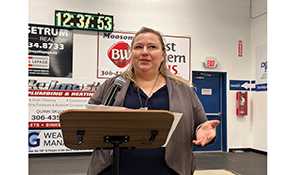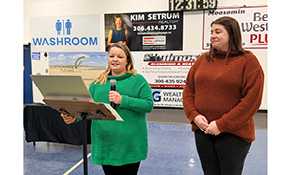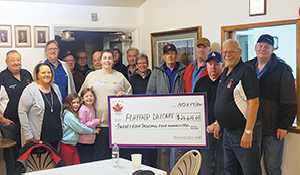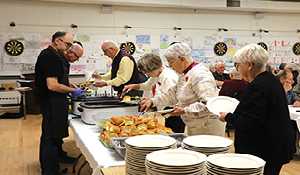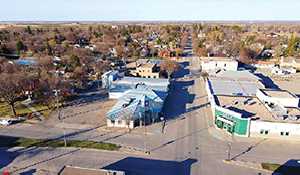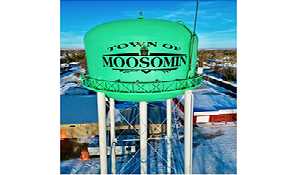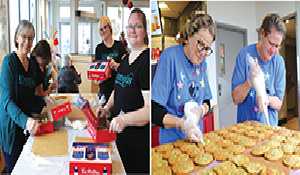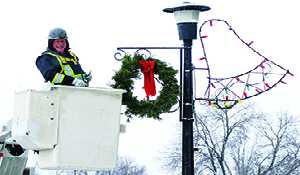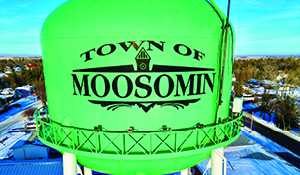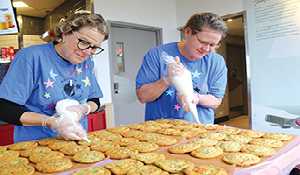School enrollment going up across the region
September 9, 2014, 3:04 am
Julia Dima


A new school year has started, and in the region, enrollment numbers are holding steady, in some places, exceeding initial projections.
In Moosomin, there are 35 more students than projected this fall—18 more at the elementary school and 17 more at the high school.
At MacLeod Elementary School in Moosomin, the initial projections for September 2014 were lower than current enrollment.
“We had a projected enrollment for this year of 259 students, and 16 pre kindergartners,” says principal Carolin St. Onge.
The current enrollment shows 277 students, and 16 pre kindergartners. Last June, numbers were lower, with a total of 278 students including the pre kindergartners. St. Onge says in general, they are seeing an upward trend in enrollment, especially with the kindergarten group.
“We were able to have an increase in staff in June, so we are able to offer three kindergarten classes this year,” St. Onge says.
Next door at McNaughton High School, things are also better than what principal Jeff St. Onge projected.
“We have a five-year prediction, and we are reasonable accurate, because we are a known commodity—we know where our kids are coming from. This year was supposed to be the lowest in our cycle, we were dropping each year, and this was supposed to be the lowest, and we’d move up again in the next few years. But this year is higher than what we thought,” says St. Onge. He says that the official enrollment number is going to fluctuate, since a few students are leaving, and a few are coming in that have not been registered, but it is about 315.
“We were projected to have 298, so we’re way higher from what we thought . . . In June, we were at about 302.”
St. Onge says this year’s projection of 298 was supposed to be the school’s lowest ever, so it came as an exciting surprise to see the increased number. He believes some of it has to do with a few larger families that have recently moved into Moosomin.
“The nice thing about this is that the increase did not hit one particular grade, it’s a couple of kids spread out in different grades, so no big workload increase for teachers,” he adds.
Rocanville School, which is a K-12 school, the current enrollment is 278 students.
“We lost a number of students, so we were sure we were going to be down this year, but we are up five from June, with 10 new students, so we are quite pleased,” says Principal Todd Volk.
He says that the numbers have not changed much from last September, but their projection for this year was 268.
“Numbers tend to be steady across the board, they may waiver a little bit, but looking at incoming kindergartens versus outgoing grade twelves, we may be looking at losing some students further down the road,” he says. Volk adds that the projections are not always accurate.
“We weren’t projecting ten new students this year, for example,” he says.
At Wapella School, there are currently 45 students enrolled, which Principal Wendy Johnson says is exactly what the projections showed. Last September, 43 students were enrolled, and Johnson says the trends show an increase.
“There are more kids coming up in the younger grades, and in kindergarten,” she says.
At Maryfield School, there are currently 107 students enrolled.
The initial projection was 117, but Principal Pam Stephen says she expects in the coming weeks, the enrollment number will come up.
“We are still enrolling all the kids at this point, and it will come together in the next few weeks,” she says.
Last September, there were about 114 enrolled, and administrator Cindy Cairns says that although this year is lower, overall enrollment is up, if kindergartners are considered as one student, as opposed to a half student, which is how they are classified now.
“Our kindergartners are considered half a student, so 10 would be counted as five. If you consider them a full time student, that would put our numbers up, we are heavy on the bottom end here,” she says.
At Wawota Parkland School, there are 156 students, and Principal Jos Risling says the enrollment number is up.
“We graduated six grade twelves last year, and we welcomed 18 kindergartners this year,” Risling says.
Risling says the increase in kindergartner students is a combination of new families in Wawota, children from Kenosee, and young families who are choosing to stay in Wawota.
There were only 8 kindergartners in September last year, and a total number of about 143 students.
Risling says the numbers they have are right on track with the projections from the school division.
“I think we’re going to have an upward trend over the next few years,” he says.
At Whitewood School, the enrollment is 254 students, which Principal Colleen Umpherville says is 10 more students than her initial projections for this year, and up from last September’s enrollment of 242.
She believes that in the long term, Whitewood School will see small increases in enrollment.
“We’ve been pretty consistent, but the data we have shows that we will probably get a little bit more students,” she says. “We have a young community, which brings new students into the school from Pre-K, and the families who come in to work in mining or at Seed Hawk may bring in kids too.”
At Kennedy School, the current enrollment is 39 students, one student up from the initial projection of 38, and up six students from June. The four-year projections provided by Prairie Valley School Division show an overall increase, with 38 in 2015, 43 in 2016 and 2017, and 48 in 2018.
“The short-term trend shows a bit of an increase. The long-term trend is stable around 40,” says Sheena August from the school division.
Elkhorn School’s enrollment numbers dropped this year, from 171 in June to 156 students currently enrolled.
“We had a very large Grade 12 class graduate, but only seven kindergartners come in,” says Principal Lance Berrate. The projections for the next few years show that the numbers will stay around that, with 157 projected for 2015, 160 in 2016, and back to 157 for 2017.
“In general, there’s less kids coming into the low end of the program,” Berrate adds.
At École St. Lazare, there are about 73 students enrolled. Principal Michelle Pétrin says that is only one student off from June’s numbers. Last September, they started with 75 students.
“It is about the same number each year—it fluctuates a little bit,” says Pétrin. “We seem to attract people who want to maintain their French language skills, so there’s a fixed group there.”
Pétrin says her goal as principal is to increase enrollment by ensuring École St. Lazare maintains high quality French education.
“My goal is to increase the number of students by five each year. I think one of the most important things is to have quality French education here,” she says.
In larger communities like Moosomin, multiculturalism in schools is on a rise, with the arrival of new immigrants, and many temporary foreign workers who came to the region becoming permanent residents.
In Moosomin, both MacLeod and McNaughton have seen an increase in new cultures represented recently.
“We’re becoming a diverse population, and we’re really excited about that,” says MacLeod Principal Carolin St. Onge.
“I am loving the diversity we are seeing,” adds McNaughton’s Principal Jeff St. Onge, “I think it’s been a good thing for our kids and school. We have access to great English as an Additional Language (EAL) programs and we do have access to online translation services, that we do use sometimes.”
The increase in new cultures prompted Southeast Cornerstone School Division to hire an EAL consultant two years ago. Liz Rowley travels to communities across the school division providing EAL training to students and teachers.
She says she is providing EAL assistance for newcomers in schools all over the division, and the Moosomin area has seen an increased demand.
“Moosomin is becoming a big one, I’ve spent a fair bit of time in Moosomin, and with that, there is some spillover into Rocanville and Wawota. Estevan has a huge number of newcomers, and Weyburn as well, and Ogema, where there is a very large Filipino community, and some new Chinese families—but even Alameda, Carnduff, and Oxbow and Carlyle have kids—so we are everywhere,” she says.
She says that by far, the largest population of EAL students in the school division come from the Philippines, but they are far from the only large group of newcomers to Southeast Saskatchewan.
“We have quite a number of Russians and Ukrainians, there’s a significant group of Mennonite Germans, we’re getting more South Asians from India and Pakistan, there’s a number of people coming from Uganda, Somalia, and Eritrea, and a few people from China and Korea,” she says.
When Rowley goes into a community, she is first helping assess the English language skills of the students, and then providing support to help them stay in the classroom but receive an education that is better suited to their specific needs.
“We are trying to keep them in their regular classes, but have the teachers use some different strategies to help those kids keep up so they know what is going on and they can learn content and English at the same time. For a student whose English is weak, you can’t expect them to read a lot out of a textbook or write an essay, but they can still learn the topic, and express what they’ve learned in different ways like acting or drawing, or putting together a poster or PowerPoint,” she says.
Other tools, like flashcards in the student’s first language are used to help someone with very little English skills communicate in the early stages, and online translation services are used for older students. Rowley says it is about more than overcoming language barriers for the newcomers—cultural barriers are just as important to address.
“We need to make everybody here aware that when newcomers come here and they may communicate in a different way than we would, that we ask and make sure we understand what they are saying,” she says. “One of the best tools is the buddy system. Then they have someone to make a friend with, and learn the ropes. It helps them relax, and kids learn more from each other. They learn English from their friends more than they do from the classroom.”
Rowley says the demand for EAL services is growing, and the school division is developing the program to meet those needs.
“The first year I was here, a group of teachers and I worked to make an assessment toolkit, so when a new student arrives, we have this toolkit that staff members are trained with to do an English language skills assessment on their own,” Rowley says. “Now, the project we are working on is getting more resources and strategies available online. We’re trying to design something that is online about how to teach and how to learn English, so teachers can use it as a guide, or if a student is comfortable, they could use that material too. We have such a wide expanse to cover in the school division, it makes sense to have things online.”
Rowley says that once she spends time with teachers helping them understand the cultural barriers they might face, they deliver the EAL material very well. Overall, she says both the schools and the communities have been supportive of the newcomers that are making Southeast Saskatchewan home now.
“For an area that has suddenly received a lot of newcomers in recent years, people have been very welcoming,” she says.
